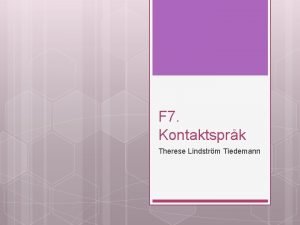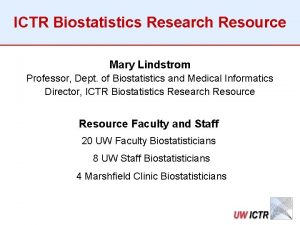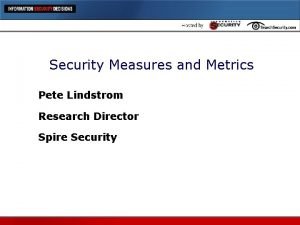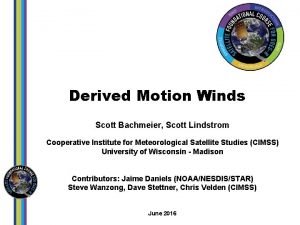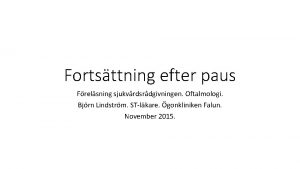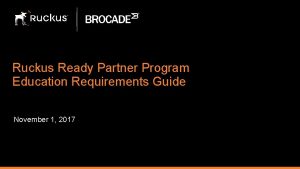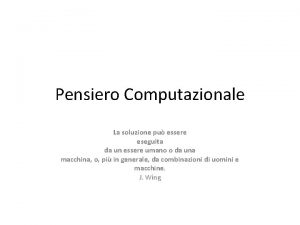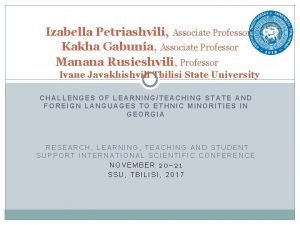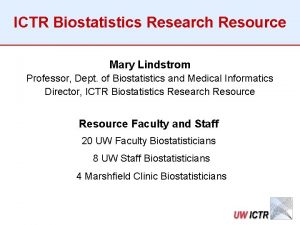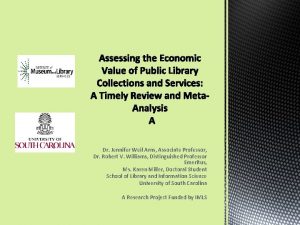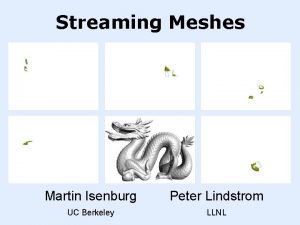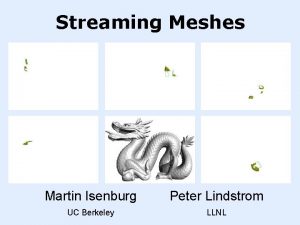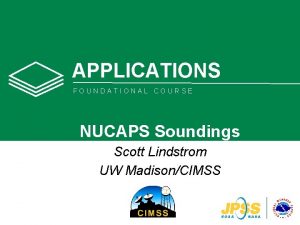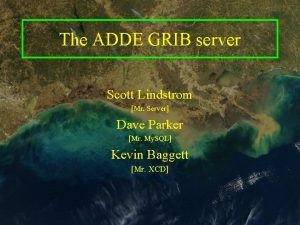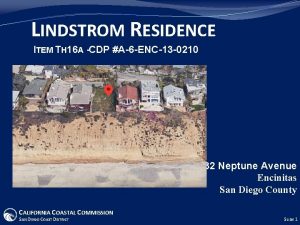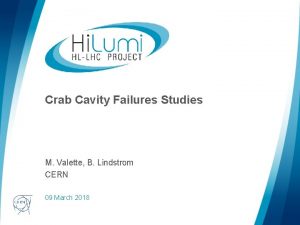Jennifer H Lindstrom Ph D Associate Professor Department

























- Slides: 25

Jennifer H. Lindstrom, Ph. D. Associate Professor Department of Communication Sciences & Special Education

Topics • Assessment and Identification in the Schools • Role of EIP • Teacher Training • Recommendations

Assessment and Identification in the Schools

Lindstrom, J. H. (2018). Dyslexia in the schools: Assessment and identification. Teaching Exceptional Children. Advance print. DOI: 10. 1177/0040059918763712

Framework for Eligibility as a Student with Dyslexia Step 1 • Collect data specific to student's reading as part of the pre-referral (i. e. , RTI) process. • Consider data collected from previous instruction and intervention (through curriculum-based measures), and review information from teacher and parents. • Refer the student to the eligibility team due to lack of sufficient progress in Tiers 1 and 2. Step 2 • Assess reading performance through the use of individually administered, norm-referenced tests of achievement and cognitive processing, as well as statewide assessments and curriculum-based measures. • Determine that the student is not achieving adequately for the child’s age or grade-level standards. Step 3 • Verify that the student's poor reading performance is not primarily due to factors included in the exclusionary criteria – visual, hearing, or motor disability; intellectual disability; emotional disturbance; cultural factors; environmental or economic disadvantage; limited-English proficiency; or lack of instruction. • This step requires sufficient assessment or review of records. Step 4 Step 5 • Consider assessing cognitive processing to determine whethere are weaknesses in any specific area associated with reading. • Specific cognitive processes linked to reading include phonological processing, orthographic awareness, rapid naming, processing speed, and working memory. • Rule-out attention issues that may be caused by deficits in executive functioning. • Provide evidence that the impact of the reading disability is of such magnitude that the student needs special education and that the student’s learning difficulties require specially designed instruction (in accordance with IDEA, 2004).

Assessing Reading and Language Skills • Demonstrate evidence of low achievement in reading (Steps 1 & 2) • Consider data specific to students’ reading performance that were collected as part of the RTI process. • Letter-naming fluency • Letter-sound fluency • Oral reading fluency • Nonsense word reading • Spelling • Oral language (vocabulary acquisition, word-finding, rhyming, grammar)

Consideration of Exclusionary Criteria • Determine that a deficit is not primarily due to factors included in the exclusionary criteria (Step 3): • visual, hearing, or motor disability; intellectual disability; emotional disturbance; cultural factors; environmental or economic disadvantage; limited English proficiency; or lack of instruction • Students in Detroit Are Suing the State Because They Weren’t Taught to Read • Too Many Children in California Can’t Read, Lawsuit Claims • The right to read: My dyslexic daughter got the help she needed. All kids should.

Consideration of Assessing Cognitive Processes • Because the operational definition of SLD is defined, in part, as “a disorder in one or more of the basic psychological processes involved in understanding or in using language, spoken or written” (20 U. S. C. § 1401[30] and 34 C. F. R. § 300. 8[c][10]), assessing cognitive processes should be considered (Step 4). • phonological processing • orthographic awareness • rapid naming • processing speed • working memory • executive functioning

Evidence of Substantial Impact • Even if a student exhibits a deficit in at least 1 area of cognitive processing that is impacting 1 or more areas of reading (i. e. , fluency, decoding), the team must determine that a student’s learning difficulties require specially designed instruction. • It is possible (though unlikely) that a student may have a SLD as identified through the operational definition but would NOT require specialized instruction due to adequate performance in the classroom.

Final Eligibility Determination • Does the student perform significantly below peers on measures of letter-sound knowledge, word decoding, reading fluency, and/or spelling? • Has the student had sufficient instruction? • Has it been determined that the difficulties identified earlier are not due to another factor, such as intellectual disability, ADHD, or emotional disturbance? • Does the student have a deficit in phonological processing, phonological memory, orthographic awareness, rapid naming, processing speed, or working memory? • Does the student have broad oral language abilities within the average range?

Role of EIP

Tier 2 Eligibility Criteria and the Identification of Dyslexia in Georgia • Purpose • To investigate the degree of alignment between schools regarding Tier 2 eligibility decision making and implementation in the state of Georgia • Research Questions • To what extent do Tier 2 eligibility criteria vary across schools in Georgia? • How closely are schools’ eligibility criteria aligned with the criteria provided by the. Ga DOE? • To what extent are schools currently using measures that can be used to identify students atrisk for dyslexia as part of the Tier 2 screening process?

Participants • The participant pool included EIP Coordinators (i. e. , Principals, Assistant Principals, Instructional Coaches) from the ~1, 000 public primary and elementary schools (including state-approved charter schools) in the state • The emails of principals from public schools in Georgia were obtained from the state Ga DOE’s office of Curriculum and Instruction. • N = 97 • Principals: 31% • Assistant principals: 18% • EIP coordinators: 16% • EIP teachers: 20% • Special education coordinators: 1% • Other: 14%

Survey • An 18 -question survey was implemented using Qualtrics • 9 background questions; 9 core questions • The survey questions addressed the following areas: (a) awareness of eligibility criteria and procedures provided by Ga DOE (b) implementation of eligibility criteria and procedures provided by Ga DOE (c) alternative or supplemental district- or school-specific Tier 2 EIP eligibility criteria and procedures, and (d) use of measures that can be used to identify students at-risk for dyslexia as part of the Tier 2 screening process.

Findings Percent of respondents who indicated that their school administered each of these early literacy measures at least twice a year to students in grades K-2.

Teacher Training


Overview of the UGA GCD Program • knowledge UGA’s Online Graduate Certificate in Dyslexia is designed to provide educators with specific related to reading disability, including reading and language development; assessment; and instruction and remediation. The program combines academic coursework, 30 hours of training in the Orton Gillingham approach for reading intervention, and hands-on experience in implementing and applying research-based intervention and instruction. It conforms to the International Dyslexia Association's (IDA) standards for preparation, certification, and professional development of teachers who serve students with reading difficulties. Currently, no other institutions of higher education in the state of Georgia offer explicit and focused training in dyslexia as part of their graduate degree program or as a stand-alone graduate certificate program. • • •

UGA GCD Current Funding • Zeist Foundation is funding 20 teachers (10 per cohort) from Atlanta Public Schools (Thomasville Heights and Slater Elementary) • In partnership with The Atlanta Speech School and The Schenck School • Teachers were nominated by their administrators; will serve as literacy/dyslexia specialists • Funding covers tuition, student fees, and course materials • On-site visits each fall and spring to The Atlanta Speech School and The Schenck School to conduct classroom observations, meet with leadership team, and learn about admissions and assessment process

Recommendations

Recommendation 1 • In grades K-2, use data collected through RTI process to identify students who are at-risk for dyslexia • Aims. Web, DIBELS, G-Kids, i. Ready, Star Enterprise, KREP • Systematically apply cut scores (e. g. , scores ≤ 25 %ile on 4/5 measures) • Place those students in Tier 2 to receive specialized instruction th by a Dyslexia Specialist (see Recommendation 4)

Recommendation 2 • Provide professional development to current Early Childhood (K-2) teachers to improve instructional practices related to reading instruction • Online modules focusing on early indicators of dyslexia and structured literacy approaches

Recommendation 3 • that Work with Early Childhood teacher preparation programs to ensure a minimum of one course focused specifically on structured literacy approaches is included in their program of study (a) explicit, systematic, and sequential teaching of literacy at multiple levels—phonemes, letter–sound relationships, syllable patterns, morphemes, vocabulary, sentence structure, paragraph structure, and text structure; (b) cumulative practice and ongoing review; (c) a high level of student– teacher interaction; (d) the use of carefully chosen examples and nonexamples; (e) decodable text; and (f) prompt, corrective feedback

Recommendation 4 • Train current EIP teachers to become Dyslexia Specialists (1 -2 per school) • Utilize those EIP teachers to provide systematic, multisensory instruction to students at-risk for, or already identified, with dyslexia (not all Tier 2 students)

Questions?
 Promotion from associate professor to professor
Promotion from associate professor to professor Jennifer lindstrom md
Jennifer lindstrom md Jens lindström
Jens lindström Blandspråk pidgin
Blandspråk pidgin Mary lindstrom uw
Mary lindstrom uw Pete lindstrom
Pete lindstrom Ruben lindström
Ruben lindström Jens lindström
Jens lindström Scott lindstrom
Scott lindstrom Joseph lindstrom
Joseph lindstrom Krokseende gula fläcken
Krokseende gula fläcken Associate director meaning
Associate director meaning Disadvantages of direct mapped cache
Disadvantages of direct mapped cache Associate consultant in capgemini
Associate consultant in capgemini Cincinnati state associate degrees
Cincinnati state associate degrees Los angeles harbor college culinary arts
Los angeles harbor college culinary arts Physician associate lecturer
Physician associate lecturer Partner portal ruckus
Partner portal ruckus Cipd experience assessment questions
Cipd experience assessment questions Imeche associate membership
Imeche associate membership Tecniche associate al pensiero computazionale
Tecniche associate al pensiero computazionale Harper college
Harper college Project associate cern
Project associate cern Associate program
Associate program Safety associate
Safety associate Why is critical thinking an active process? *
Why is critical thinking an active process? *



